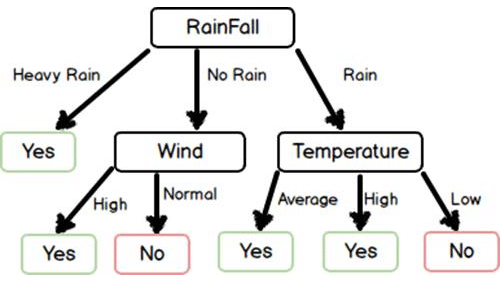1
2
3
4
5
6
7
8
9
10
11
12
13
14
15
16
17
18
19
20
21
22
23
24
25
26
27
28
29
30
31
32
33
34
35
36
37
38
39
40
41
42
43
44
45
46
47
48
49
50
51
52
53
54
55
56
57
58
59
60
61
62
63
64
65
66
67
68
69
70
71
72
73
74
75
76
77
78
79
|
decisionNode = dict(boxstyle="square", ec='k', fc='yellow',)
leafNode = dict(boxstyle="round", ec=(1., 0.5, 0.5), fc=(1., 0.8, 0.8),)
arrow_args = dict(arrowstyle='<-')
def plotNode(nodeTxt, centerPt, parentPt, nodeType):
createPlot.ax1.annotate(nodeTxt, xy=parentPt, xycoords='axes fraction',
xytext=centerPt, textcoords='axes fraction',
va='center', ha='center', bbox=nodeType, arrowprops=arrow_args)
def createPlot():
fig=plt.figure(1,facecolor = 'white')
fig.clf()
createPlot.ax1=plt.subplot(111, frameon=False)
plotNode('决策节点', (0.5,0.1), (0.1,0.5), decisionNode)
plotNode('叶节点', (0.8,0.1), (0.3,0.8), leafNode)
plt.show()
def getNumLeafs(myTree):
numLeafs=0
firstStr=list(myTree.keys())[0]
secondDict=myTree[firstStr]
for key in secondDict.keys():
if type(secondDict[key]).__name__=='dict':
numLeafs+=getNumLeafs(secondDict[key])
else:numLeafs+=1
return numLeafs
def getTreeDepth(myTree):
maxDepth=0
firstStr=list(myTree.keys())[0]
secondDict=myTree[firstStr]
for key in secondDict.keys():
if type(secondDict[key]).__name__=='dict':
thisDepth=1+getTreeDepth(secondDict[key])
else: thisDepth=1
if thisDepth > maxDepth:
maxDepth=thisDepth
return maxDepth
def plotMidText(cntrPt,parentPt,txtString):
xMid=(parentPt[0]-cntrPt[0])/2+cntrPt[0]
yMid=(parentPt[1]-cntrPt[1])/2+cntrPt[1]
createPlot.ax1.text(xMid,yMid,txtString)
def plotTree(myTree, parentPt, nodeTxt):
numLeafs=getNumLeafs(myTree)
depth=getTreeDepth(myTree)
firstStr=list(myTree.keys())[0]
cntrPt=(plotTree.xOff+(1.0+float(numLeafs))/2/plotTree.totalW,plotTree.yOff)
plotMidText(cntrPt, parentPt, nodeTxt)
plotNode(firstStr, cntrPt, parentPt, decisionNode)
secondDict=myTree[firstStr]
plotTree.yOff=plotTree.yOff -1/plotTree.totalD
for key in secondDict.keys():
if type(secondDict[key]).__name__=='dict':
plotTree(secondDict[key], cntrPt, str(key))
else:
plotTree.xOff=plotTree.xOff+1.0/plotTree.totalW
plotNode(secondDict[key],(plotTree.xOff,plotTree.yOff),cntrPt,leafNode)
plotMidText((plotTree.xOff,plotTree.yOff),cntrPt,str(key))
plotTree.yOff=plotTree.yOff+1/plotTree.totalD
def createPlot(inTree):
fig = plt.figure(1, facecolor='white')
fig.clf()
axprops = dict(xticks=[], yticks=[])
createPlot.ax1 = plt.subplot(111, frameon=False, **axprops)
plotTree.totalW = float(getNumLeafs(inTree))
plotTree.totalD = float(getTreeDepth(inTree))
plotTree.xOff = -0.5/plotTree.totalW; plotTree.yOff = 1.0;
plotTree(inTree, (0.5, 1.0), '')
plt.show()
|

